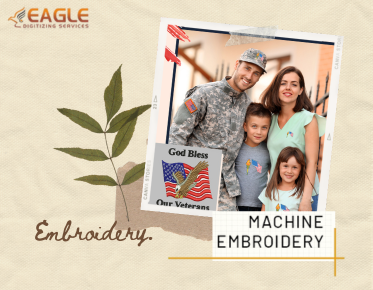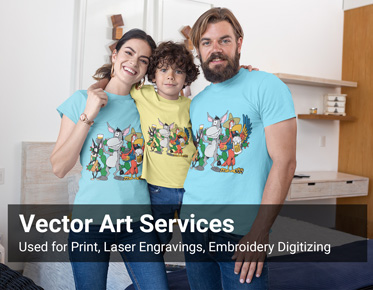Machine Embroidery Made Easy: A Breezy Overview/Eagle Digitizing
Machine embroidery is the process of using a sewing machine or an embroidery machine to create patterns on textiles. It's an intricate art that combines creativity with precision, allowing for the creation of stunning designs on fabric. Unlike hand embroidery, machine embroidery offers speed, uniformity, and the ability to replicate complex patterns with ease. Here are Some Points You Should Be Aware of Regarding Embroidery Digitizing !
A Brief History of Embroidery Machines
The journey of machine embroidery began in the early 19th century with the invention of the first embroidery machine by Josué Heilmann in 1828. This invention was revolutionary, although it was manually operated. The significant leap came in the mid-20th century with the advent of computerized embroidery machines. These machines could read digital patterns and execute them with precision, forever transforming the embroidery landscape.
Types of Machine Embroidery
Domestic vs. Commercial Embroidery Machines
Domestic embroidery machines are designed for hobbyists and small-scale projects. They are generally more affordable, user-friendly, and suitable for personal use. On the other hand, commercial embroidery machines are robust, high-speed machines capable of handling large volumes of work. They are equipped with multiple needles and advanced features for professional use.
Computerized vs. Manual Embroidery Machines
Computerized embroidery machines use software to create and edit designs, offering a vast array of patterns and customization options. These machines are ideal for intricate and precise work. Manual embroidery machines, while less common today, require more hands-on control and are often used for simple, straightforward designs.
Key Components of an Embroidery Machine
The Embroidery Hoop
The embroidery hoop holds the fabric taut and stable during stitching. This stability is essential to prevent shifting or bunching, which can ruin the design. The hoop keeps the fabric in place, ensuring that each stitch is consistently placed according to the design specifications.
The Needle
Embroidery needles are designed with a larger eye to accommodate the thicker embroidery threads. Common types include ballpoint needles, which are ideal for knit fabrics, and sharp needles, which work well on woven fabrics. Specialized needles, like twin or triple needles, can create decorative stitching effects.
The Bobbin and Bobbin Case
The bobbin is a small, cylindrical component that holds the lower thread used in conjunction with the upper thread to create stitches. It works with the bobbin case, which holds the bobbin in place and ensures proper tension. Together, they contribute to the uniformity and consistency of the embroidery.
Thread Tension Mechanism
Thread tension refers to the tightness or looseness of the threads as they feed through the machine. Proper tension is vital for balanced stitches and to prevent puckering or thread breakage. Tension adjustments may be necessary depending on the type of thread and fabric used.
The Thread Guide
The thread guide directs the thread from the spool through the various tension mechanisms and to the needle. It ensures smooth and consistent thread flow, preventing tangling or skipping. Proper thread guide alignment is crucial for maintaining stitch quality.
The Upper Thread Path
The upper thread path includes all the components through which the thread passes before reaching the needle. This path typically includes the spool pin, thread guide, tension discs, and take-up lever. Each part plays a role in ensuring the thread feeds evenly and correctly.
The Feed Dogs
Feed dogs are small, toothed components located beneath the needle plate. They move the fabric forward and backward during stitching, ensuring that the fabric progresses evenly. Proper functioning of the feed dogs is crucial for consistent stitch placement.
The Presser Foot
Presser feet come in various types, including standard, zipper, walking, and specialty feet. Each type serves a specific function, such as sewing zippers, quilting, or creating decorative stitches. Choosing the right presser foot for your project enhances the quality and ease of stitching.
The Control Panel
The control panel allows users to adjust settings, select designs, and monitor the machine’s status. It typically includes buttons, dials, and a display screen for easy navigation and customization. Familiarizing yourself with the control panel enhances your efficiency and precision.
The Motor
The motor powers the various moving parts of the embroidery machine, including the needle and feed dogs. It drives the stitching mechanism and ensures smooth and consistent operation. A well-functioning motor is essential for reliable and efficient embroidery.
The Embroidery Arm
The embroidery arm is the part of the machine that holds the hoop and moves it in various directions during stitching. It is responsible for positioning the fabric and ensuring accurate stitching according to the design.
The Needle Plate
The needle plate provides a stable surface for the needle and fabric during stitching. It often features markings to help with accurate fabric positioning and stitching alignment. The needle plate plays a vital role in maintaining stitch consistency.
The Bobbin Winder
The bobbin winder is responsible for winding thread onto the bobbin, preparing it for use in the machine. It ensures that the bobbin is evenly filled with thread, which is essential for consistent stitching.
The Frame or Carriage System
The frame or carriage system supports and moves the embroidery hoop during stitching. It ensures that the hoop remains in the correct position and that the fabric is fed smoothly. The frame is essential for achieving accurate and consistent embroidery.
The Stitch Regulator
A stitch regulator controls the length and consistency of stitches during embroidery. It ensures that each stitch is uniform and accurately placed according to the design. Proper regulation is crucial for achieving high-quality embroidery.
Getting Started with Machine Embroidery
Choosing the Right Machine for Beginners
For beginners, it's essential to choose a machine that balances functionality with ease of use. Look for features like an automatic needle threader, built-in designs, and a user-friendly interface.
Essential Tools and Materials
Beyond the machine, you'll need a variety of tools such as embroidery hoops, stabilizers, a selection of threads, and needles. Additionally, a good pair of embroidery scissors and a seam ripper are invaluable.
Setting Up Your Embroidery Workspace
A well-organized workspace enhances productivity and creativity. Ensure you have a sturdy table for your machine, good lighting, and ample storage for your materials and tools.
Understanding Embroidery Designs
Types of Embroidery Designs
Embroidery designs range from simple monograms to intricate floral patterns. They can be classified into categories such as free-standing lace, appliqué, and in-the-hoop designs.
Where to Find Embroidery Patterns
Embroidery patterns can be found in various places, including online marketplaces, embroidery magazines, and through software libraries. Many websites offer both free and paid patterns.
Customizing Embroidery Designs
Customizing designs involves altering elements like size, color, and stitch type. With the right software, you can personalize patterns to suit specific projects or preferences.
Preparing Fabric for Embroidery
Selecting the Best Fabric
The choice of fabric impacts the final look of the embroidery. Cotton, linen, and denim are popular choices, but the fabric should be sturdy enough to handle the stitching without distorting.
Stabilizers: What Are They and Why Use Them?
Stabilizers provide extra support to the fabric during embroidery, preventing puckering and stretching. They are available in different varieties, including water-soluble, cut-away, and tear-away.
Hooping Techniques for Different Fabrics
Proper hooping techniques ensure the fabric remains taut throughout the embroidery process. Techniques vary depending on the fabric type and the design complexity.
Embroidery Techniques and Stitches
Basic Stitches for Machine Embroidery
Basic stitches include the running stitch, satin stitch, and fill stitch. These foundational stitches are used to create outlines, fills, and details in embroidery designs.
Advanced Stitching Techniques
Advanced techniques involve combining different stitches, using multiple thread colors, and incorporating specialty threads to add texture and depth to the designs.
Adding Texture and Dimension
Adding texture and dimension can be achieved through techniques like 3D puff embroidery, appliqué, and using varied thread types such as metallic or variegated threads.
Working with Embroidery Software
Overview of Popular Embroidery Software
Popular embroidery software includes programs like Brother's PE-Design, Bernina's ArtLink, and Hatch Embroidery. These programs offer features for design creation, editing, and digitizing.
Digitizing Your Own Designs
Transforming artwork into a digital embroidery file is called digitizing. This involves outlining the design, assigning stitch types, and sequencing the stitching order.
Editing and Customizing Patterns
Editing patterns allows for adjustments in size, color, and stitch density. Customizing patterns involves altering elements to fit specific project needs or personal preferences.
Common Embroidery Projects
Personalizing Clothing and Accessories
Personalizing items like shirts, hats, and bags adds a unique touch. Embroidery can be used to add monograms, logos, or custom designs to these items.
Creating Home Décor Items
Embroidery can enhance home décor items such as pillows, curtains, and table runners. Custom designs can be created to match the interior aesthetics.
Crafting Gifts and Keepsakes
Handcrafted gifts like embroidered handkerchiefs, towels, and baby blankets are cherished keepsakes. Personalized embroidery adds sentimental value to these items.
Troubleshooting Common Issues
Thread Breakage and Tension Problems
Thread breakage can be caused by incorrect tension, old thread, or needle issues. Regularly check and adjust the tension settings and replace the needle if necessary.
Puckering and Distortion
Puckering can result from improper hooping or insufficient stabilizer use. Ensure the fabric is taut in the hoop and use the appropriate stabilizer for the fabric type.
Needle and Bobbin Challenges
Needle and bobbin issues can disrupt embroidery. Regularly clean the bobbin case, use the correct needle for the fabric, and ensure the bobbin is wound correctly.
Maintenance and Care for Your Embroidery Machine
Regular Cleaning Tips
Regular cleaning involves removing lint, dust, and thread remnants from the machine. Use a small brush and follow the manufacturer's instructions for proper cleaning.
Routine Maintenance Checklist
Routine maintenance includes oiling the machine, checking for loose screws, and ensuring the needle and bobbin are in good condition. Regular maintenance prolongs the machine's lifespan.
When to Seek Professional Help
If the machine exhibits persistent problems, unusual noises, or operational issues, it may be time to seek professional help. Complex problems can be diagnosed and fixed by a skilled technician.
Machine embroidery is a fulfilling and creative endeavor. It combines artistry with technology, allowing for endless possibilities and personalized creations. Embark on your embroidery journey with confidence and curiosity. The skills and techniques you develop will open up a world of creative expression and satisfaction.



